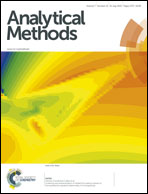Identification of beef spoilage via the analysis of volatiles using long optical-path Fourier transform infrared spectroscopy
Abstract
Based on the analysis of specific volatile substances released during beef spoilage, the beef status can be predicted. During beef spoilage, ammonia, carbon dioxide, alcohols, esters, aldehydes, ketones, and other substances are released and can be detected by long-path FITR (Fourier transform infrared spectroscopy). The concentrations of these substances vary with storage time. We could distinguish beef at different stages of spoilage using FTIR spectrometry combined with chemometric methods. This study indicates that infrared spectroscopy can be used to monitor the spoilage status of beef.


 Please wait while we load your content...
Please wait while we load your content...